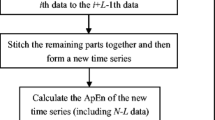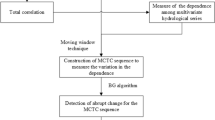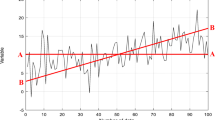Abstract
The jump points detection is critical to the understanding of hydrologic variability, especially in investigating the anthropogenic effects. Conventional methods are mainly statistical and cannot directly reflect the jump change degrees. This article proposes a moving correlation coefficient-based detection (MCCD) method for the detection of jump points (JPs) in hydroclimate data. The correlation coefficient (CC) between the potential jump component and the original data is calculated, and the CC series is realized by moving from the starting to the ending points of the original time series. Bigger CC value reflects higher jump degree; the position with the biggest absolute CC value is the JP that is the most expected. Its significance is evaluated by comparing its value with the CC threshold value at the relevant significance level. Monte-Carlo experimental results verify the MCCD method’s higher efficiency compared with four commonly used conventional methods. It is especially noteworthy that the results indicate its stable efficiency, even when encountering the influences of some unfavorable factors. By applying the MCCD method to the Lancang River Basin, the JP of runoff in 2004 is detected at the Yunjinghong station in the lower reach. It is mainly attributed to the construction and operation of some major water hydropower projects, while the stable variations of areal precipitation and actual evapotranspiration, as well as the stable land-cover conditions, contribute little to the abrupt decrease in runoff. The MCCD method can be an effective alternative for the detection of JPs in hydroclimate data.








Similar content being viewed by others
References
Ahmadi F, Tahroudi MN, Mirabbasi R, Khalili K, Jhajharia D (2018) Spatiotemporal trend and abrupt change analysis of temperature in Iran. Meteorol Appl 25(2):314–321
Bayraktar H, Turalioglu FS, Şen Z (2005) The estimation of average areal rainfall by percentage weighting polygon method in Southeastern Anatolia Region, Turkey. Atmos Res 73(1–2):149–160
Brown MB, Forsythe AB (1974) Robust tests for equality of variances. J Am Stat Assoc 69(346):364–367
Cockburn JMH, Garver JI (2015) Abrupt change in runoff on the north slope of the Catskill Mountains, NY, USA: above average discharge in the last two decades. J Hydrol Reg Stud 3:199–210
Dessie M et al (2015) Water balance of a lake with floodplain buffering: Lake Tana, Blue Nile Basin, Ethiopia. J Hydrol 522:174–186
Ding J, Deng Y (1988) Statistical hydrology. Press of University of Science and Technology of Chengdu, Chengdu
Domonkos P (2013) Efficiencies of inhomogeneity-detection algorithms: comparison of different detection methods and efficiency measures. J Climatol. https://doi.org/10.1155/2013/390945
Dugan PJ et al (2010) Fish migration, dams, and loss of ecosystem services in the Mekong Basin. Ambio 39(4):344
Fan H, He D, Wang H (2015) Environmental consequences of damming the mainstream Lancang-Mekong River: a review. Earth Sci Rev 146:77–91
Fu B (1996) On the calculation of evaporation from land surface in mountainous areas. J Meteorol Sci 04:328–335
Furey P, Kampf SK, Lanini J, Dozier A (2010) Examining the vulnerability of hydropower production in meso-scale snowmelt-runoff basins under different climate change scenarios. AGU fall meeting
Gagné MÈ, Kirchmeier-Young MC, Gillett NP, Fyfe JC (2017) Arctic sea ice response to the eruptions of Agung, El Chichón, and Pinatubo. J Geophys Res Atmos 122(15):8071–8078
Karpechko AY, Gillett NP, Dall’Amico M, Gray LJ (2010) Southern hemisphere atmospheric circulation response to the El Chichón and Pinatubo eruptions in coupled climate models. Q J R Meteorol Soc 136(652):1813–1822
Kundzewicz ZW, Robson AJ (2004) Change detection in hydrological records—a review of the methodology. Int Assoc Sci Hydrol Bull 49(1):7–19
Lauri H et al (2012) Future changes in Mekong River hydrology: impact of climate change and reservoir operation on discharge. Hydrol Earth Syst Sci 16(12):4603–4619
Li S, Xiong L, Li H et al (2016) Attributing runoff changes to climate variability and human activities: uncertainty analysis using four monthly water balance models. Stoch Env Res Risk Assess 30(1):251–269. https://doi.org/10.1007/s00477-015-1083-8
Mann HB (1945) Nonparametric tests against trend. Econometrica 13(3):245–259
Montanari A (2012) Detecting and quantify non-stationarity: a look to a changing hydrology for a changing society and environment and a perspective on the next IAHS Scientific Decade 2013–2022. AGU fall meeting
Murphy KR, Myors B (2004) Statistical power analysis: a simple and general model for traditional and modern hypothesis tests. Lawrence Erlbaum Associates, New Jersey, pp 539–542
Nasseribrahim A, Yasushi M, Masahiro M (2005) Remote sensing algorithms for monitoring eutrophication in Ishizuchi storm water reservoir in Kochi Prefecture, Japan. Hydrol Sci J 50(3):542. https://doi.org/10.1623/hysj.50.3.525.65024
Perreault L et al (1999) Detection of changes in precipitation and runoff over eastern canada and U.S. using a Bayesian approach. Stoch Env Res Risk Assess 13(3):201–216. https://doi.org/10.1007/s004770050039
Pettitt AN (1979) A non-parametric approach to the change-point problem. J Roy Stat Soc 28(2):126–135
Reeves J, Chen J, Wang XL, Lund R, Lu Q (2007) A review and comparison of change point detection techniques for climate data. J Appl Meteorol Climatol 46(6):900
Rougé C, Ge Y, Cai X (2013) Detecting gradual and abrupt changes in hydrological records. Adv Water Resour 53:33–44. https://doi.org/10.1016/j.advwatres.2012.09.008
Sang YF, Wang ZG, Li ZL (2012) Entropy aided detection of abrupt climate change: a case study in the Haihe River Basin, China. Entropy 14(7):1274–1284
Şen Z (2017) Innovative trend methodologies in science and engineering. Springer, Heidelberg
Shi W, Yu X, Liao W, Wang Y, Jia B (2013) Spatial and temporal variability of daily precipitation concentration in the Lancang River Basin, China. J Hydrol 495:197–207
Sun F (2007) Study on watershed evapotranspiration based on the Budyko Hypothesis. Tsinghua University, Beijing
Veihe A, Quinton J (2015) Sensitivity analysis of EUROSEM using Monte Carlo simulation I: hydrological, soil and vegetation parameters. Hydrol Process 14(5):915–926
Villarini G, Serinaldi F, Smith JA, Krajewski WF (2009) On the stationarity of annual flood peaks in the continental United States during the 20th century. Water Resour Res 45(8):2263–2289
Wikle CK (2003) Modeling hydrologic change: statistical methods. Technometrics 45(4):366–367
Xie P, Liu Y, Yang GL et al (2012) Attribution analysis of water resources alteration in the Third Grade Wulijimurenhe. J China Hydrol 32(2):40–43
Xie P, Wu ZY, Sang YF et al (2018) Evaluation of the significance of abrupt changes in precipitation and runoff process in China. J Hydrol 560:451–460
Yang T et al (2009) Spatio-temporal changes of hydrological processes and underlying driving forces in guizhou region, southwest china. Stoch Env Res Risk Assess 23(8):1071–1087. https://doi.org/10.1007/s00477-008-0278-7
Zhang J, Huang Q, Zhao X (2013) Comparative research on abrupt change analysis methods for hydrological time series in Zhangze reservoir. J Basic Sci Eng 21(5):837–844
Zhou Y, Shi C, Fan X, Du J (2011) Advances in the research methods of abrupt changes of hydrologic sequences and their applications in drainage basins in China. Progr Geogr 30(11):1361–1369
Acknowledgements
The authors gratefully acknowledge the valuable comments and suggestions given by the editors and the anonymous reviewers. This study was financially supported by the National Natural Science Foundation of China (No. 91547205, 91647110, 51579181, 51779176), the Strategic Priority Research Program of Chinese Academy of Sciences (No. XDA20060402), and the Youth Innovation Promotion Association CAS (No. 2017074).
Author information
Authors and Affiliations
Corresponding authors
Additional information
Publisher's Note
Springer Nature remains neutral with regard to jurisdictional claims in published maps and institutional affiliations.
Appendices
Appendix 1: Groups of parameters used in statistical experiments
Group | \( n \) | \( EX \) | \( Cv \) | \( Cs \) | \( q \) | \( a \) |
|---|---|---|---|---|---|---|
1 | 50, 100, 150, 200, 250, 300, 350, 400, 450, 500 | 500 | 0.5 | 2.0 | 300 | 0.5 |
2 | 200 | 100, 300, 500, 700, 900 | 0.5 | 2.0 | 300 | 0.5 |
3 | 200 | 500 | 0.1, 0.2, 0.3, 0.4, 0.5, 0.6, 0.7, 0.8, 0.9 | 2.0 | 300 | 0.5 |
4 | 200 | 500 | 0.5 | 1.0, 1.5, 2.0, 2.5, 3.0 | 300 | 0.5 |
5 | 200 | 500 | 0.5 | 2.0 | 100, 150, 200, 250, 300, 350, 400, 450, 500 | 0.5 |
6 | 200 | 500 | 0.5 | 2.0 | 300 | 0.1, 0.2, 0.3, 0.4, 0.5, 0.6, 0.7, 0.8, 0.9 |
Appendix 2: Mathematical expressions of the four jump point detection methods used in the statistical experiments
Method | Category | Mathematical expression | Core statistics | Indicator for jump point |
|---|---|---|---|---|
Pettitt | Non-parametric | \( U_{t,N} = U_{t - 1,N} + \sum\limits_{i = 1}^{N} {\text{sgn} (x_{t} - x_{i} )} ,\quad t = 2,3, \ldots ,N \) \( K_{t,N} = \hbox{max} \left| {U_{t,N} } \right|,\quad (1 \le t \le N) \) | \( K_{t,N} \) | \( p \le 0.05 \) |
M–K | Non-parametric | \( UF_{k} = \frac{{s_{k} - \overline{{s_{k} }} }}{{\sqrt {\text{var} (s_{k} )} }},\quad s_{k} = \sum\limits_{i = 1}^{k} {\sum\limits_{j}^{i - 1} {a_{i,j} (k = 2,3, \ldots ,n),\quad a_{i,j} = \left\{ {\begin{array}{*{20}l} {1,} \hfill & {x_{i} > x_{j} } \hfill \\ {0,} \hfill & {x_{i} \le x_{j} } \hfill \\ \end{array} } \right.} } \) | \( s_{k} \) | \( \left\{ {\begin{array}{*{20}c} {\left| {UB_{k} } \right| < U_{\alpha /2} } \\ {\left| {UF_{k} } \right| < U_{\alpha /2} } \\ {UB_{k} = UF_{k} } \\ \end{array} } \right. \) |
B–F | Parametric | \( F = \sum\limits_{i = 1}^{m} {n_{i} (\overline{{x_{1} }} - \bar{x})^{2} } /\sum\limits_{i = 1}^{m} {(1 - n_{i} /N)S_{i}^{2} } \) | \( F \) | \( F > F_{\alpha } \) |
Bayesian | Parametric | \( P(H|E) = \frac{P(E|H)P(H)}{P(E)} \) | – | Max posterior probability |
Rights and permissions
About this article
Cite this article
Wu, Z., Xie, P., Sang, YF. et al. Moving correlation coefficient-based method for jump points detection in hydroclimate time series. Stoch Environ Res Risk Assess 33, 1751–1764 (2019). https://doi.org/10.1007/s00477-019-01727-6
Published:
Issue Date:
DOI: https://doi.org/10.1007/s00477-019-01727-6




